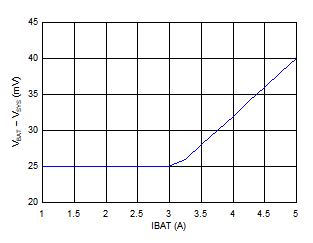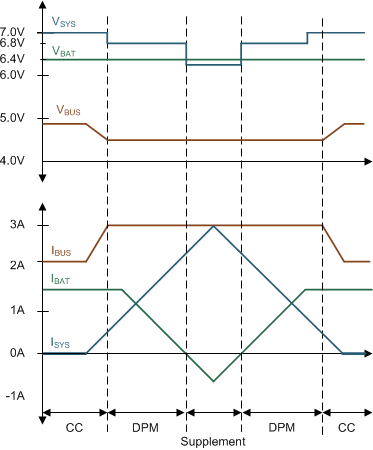ZHCSMD3C June 2020 – August 2022 BQ25792
PRODUCTION DATA
- 1 特性
- 2 应用
- 3 说明
- 4 Revision History
- 5 说明(续)
- 6 Device Comparison
- 7 Pin Configuration and Functions
- 8 Specifications
-
9 Detailed Description
- 9.1 Overview
- 9.2 Functional Block Diagram
- 9.3
Feature Description
- 9.3.1 Device Power-On-Reset
- 9.3.2 PROG Pin Configuration
- 9.3.3 Device Power Up from Battery without Input Source
- 9.3.4 Device Power Up from Input Source
- 9.3.5 Dual-Input Power Mux
- 9.3.6 Buck-Boost Converter Operation
- 9.3.7 USB On-The-Go (OTG)
- 9.3.8 Power Path Management
- 9.3.9 Battery Charging Management
- 9.3.10 Integrated 16-Bit ADC for Monitoring
- 9.3.11 Status Outputs ( STAT, and INT)
- 9.3.12 Ship FET Control
- 9.3.13 Protections
- 9.3.14 Serial Interface
- 9.4 Device Functional Modes
- 9.5 Register Map
- 10Application and Implementation
- 11Power Supply Recommendations
- 12Layout
- 13Device and Documentation Support
- 14Mechanical, Packaging, and Orderable Information
9.3.8.2 Dynamic Power Management
To use the maximum available current from the input power source without over loading the adapter, the BQ25792 features Dynamic Power Management (DPM), which continuously monitors the input current and input voltage. When the input power at the VBUS pin is too low to support the load from SYS pin and the battery charge current from BAT pin, the charger engages either IINDPM to limit its current or VINDPM to prevent further reduction in VBUS pin voltage.
When the system voltage is regulated at VSYSMIN and SYS voltage temporarily drops lower than VSYSMIN, the VSYSMIN loop reduces charging current so that the SYS voltage remains at the VSYSMIN level. If the charge current falls to zero, but the input source is still overloaded, the SYS voltage will drop. Once the SYS voltage falls below the battery voltage, the device automatically enters supplement mode in which the BATFET turns on. The battery starts discharging so that the system is supported from both the input source and battery. The battery FET operates in ideal diode mode, driving the battery FET gate voltage to regulate the BATFET VDS at 25 mV for low current. This prevents SYS voltage oscillations from entering and exiting the supplement mode. As the discharge current increases, the ideal diode loop drives the BATFET gate to a higher voltage, in order to reduce the battery FET RDS(ON) until the BATFET is fully turned on. Once the BATFET is fully on, the VDS linearly increases with the discharge current. Figure 9-7 shows the V-I curve of the BATFET ideal diode operation. The BATFET turns off to exit supplement mode when the battery is below battery depletion threshold.
 Figure 9-7 BATFET I-V Curve
Figure 9-7 BATFET I-V CurveDuring DPM mode, the status register bits VINDPM_STAT (VINDPM) and/or IINDPM_STAT (IINDPM) go high. Figure 9-8 shows the DPM response with 5V/3A adapter, 6.4V battery, 1.5A charge current and 6.8V minimum system voltage setting.
 Figure 9-8 DPM Response
Figure 9-8 DPM Response